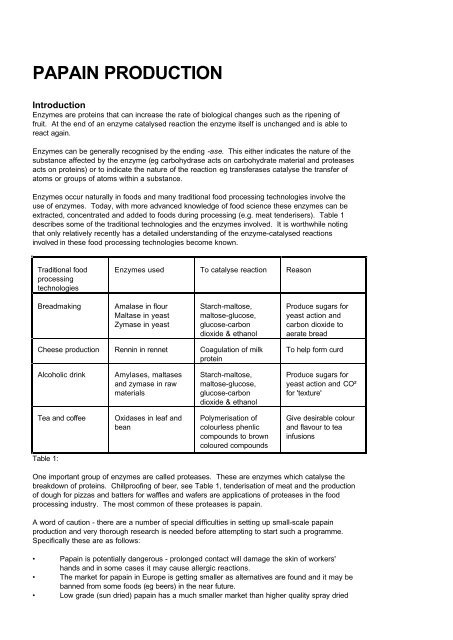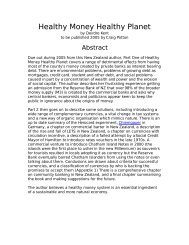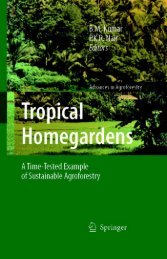Papain Production - library.uniteddiversity.coop
Papain Production - library.uniteddiversity.coop
Papain Production - library.uniteddiversity.coop
You also want an ePaper? Increase the reach of your titles
YUMPU automatically turns print PDFs into web optimized ePapers that Google loves.
PAPAIN PRODUCTION<br />
Introduction<br />
Enzymes are proteins that can increase the rate of biological changes such as the ripening of<br />
fruit. At the end of an enzyme catalysed reaction the enzyme itself is unchanged and is able to<br />
react again.<br />
Enzymes can be generally recognised by the ending -ase. This either indicates the nature of the<br />
substance affected by the enzyme (eg carbohydrase acts on carbohydrate material and proteases<br />
acts on proteins) or to indicate the nature of the reaction eg transferases catalyse the transfer of<br />
atoms or groups of atoms within a substance.<br />
Enzymes occur naturally in foods and many traditional food processing technologies involve the<br />
use of enzymes. Today, with more advanced knowledge of food science these enzymes can be<br />
extracted, concentrated and added to foods during processing (e.g. meat tenderisers). Table 1<br />
describes some of the traditional technologies and the enzymes involved. It is worthwhile noting<br />
that only relatively recently has a detailed understanding of the enzyme-catalysed reactions<br />
involved in these food processing technologies become known.<br />
Traditional food<br />
processing<br />
technologies<br />
Breadmaking Amalase in flour<br />
Maltase in yeast<br />
Zymase in yeast<br />
Enzymes used To catalyse reaction Reason<br />
Starch-maltose,<br />
maltose-glucose,<br />
glucose-carbon<br />
dioxide & ethanol<br />
Cheese production Rennin in rennet Coagulation of milk<br />
protein<br />
Alcoholic drink Amylases, maltases<br />
and zymase in raw<br />
materials<br />
Tea and coffee Oxidases in leaf and<br />
bean<br />
Table 1:<br />
Starch-maltose,<br />
maltose-glucose,<br />
glucose-carbon<br />
dioxide & ethanol<br />
Polymerisation of<br />
colourless phenlic<br />
compounds to brown<br />
coloured compounds<br />
Produce sugars for<br />
yeast action and<br />
carbon dioxide to<br />
aerate bread<br />
To help form curd<br />
Produce sugars for<br />
yeast action and CO²<br />
for 'texture'<br />
Give desirable colour<br />
and flavour to tea<br />
infusions<br />
One important group of enzymes are called proteases. These are enzymes which catalyse the<br />
breakdown of proteins. Chillproofing of beer, see Table 1, tenderisation of meat and the production<br />
of dough for pizzas and batters for waffles and wafers are applications of proteases in the food<br />
processing industry. The most common of these proteases is papain.<br />
A word of caution - there are a number of special difficulties in setting up small-scale papain<br />
production and very thorough research is needed before attempting to start such a programme.<br />
Specifically these are as follows:<br />
• <strong>Papain</strong> is potentially dangerous - prolonged contact will damage the skin of workers'<br />
hands and in some cases it may cause allergic reactions.<br />
• The market for papain in Europe is getting smaller as alternatives are found and it may be<br />
banned from some foods (eg beers) in the near future.<br />
• Low grade (sun dried) papain has a much smaller market than higher quality spray dried
<strong>Papain</strong> <strong>Production</strong> Intermediate Technology Development Group<br />
papain (see below). Therefore a thorough market survey should be made to ensure that<br />
the product can be sold.<br />
• Plantations of papaya trees are needed for economical production-collection from a few<br />
trees in home gardens is not a viable activity.<br />
<strong>Papain</strong>: source and uses<br />
<strong>Papain</strong> is in the dried latex obtained from the papaya fruit (Carica papaya L). It is the protease<br />
which is most commonly used for the food processing applications mentioned above. However,<br />
other proteases which are important are ficin which is obtained from figs and bromelain which is<br />
tained from pineapple.<br />
<strong>Papain</strong> is used in the pharmaceutical industry, in medicine as well as in the food processing<br />
industry (eg in the preparation of vaccines and for the treatment of hard skin). It also has<br />
veterinary applications such as deworming of cattle. <strong>Papain</strong> is also used in the tanning of leather<br />
and has applications in the paper and adhesive industries as well as in sewage disposal. Medical<br />
research includes plastic surgery on cleft palates using papain.<br />
Methods of collection and extraction<br />
<strong>Papain</strong> is obtained by cutting the skin of the unripe but almost mature papaya and then collecting<br />
and drying the latex which flows from the cuts. Tapping of the fruit should start early in the<br />
morning and finish by mid-late morning (ie during periods of high humidity). At low humidity the<br />
flow of latex is low.<br />
Two or three vertical cuts (except the first cut, see below) 1-2mm deep are then made, meeting at<br />
the base of the fruit. The incisions are made using a stainless steel razor blade set into a piece<br />
of rubber attached to a long stick. The blade should not protrude more than about 2mm as cuts<br />
deeper than 2mm risk juices and starch from the fruit pulp mixing with the latex which lowers the<br />
quality.<br />
Fruits should be tapped at intervals of about 4-7 days and for the first tapping it is usually<br />
sufficient to make only one cut. On subsequent tappings the two or three cuts are spaced<br />
between earlier ones (as explained above).<br />
After about 4-6 minutes the flow of latex ceases. A dish is used to collect the latex and the latex<br />
is then scraped into a polythene lined box with a close fitting lid; such a box should be stored in<br />
the shade. The use of a close fitting lid and keeping the box in the shade are both important<br />
because they reduce the reactions which cause the loss of enzyme activity. Foreign matter such<br />
as dirt and insects in the latex should be avoided. Latex adhering to the fruit should be carefully<br />
scraped off and transferred to the collecting box. However, dried latex should not be mixed with<br />
fresh latex as this lowers the quality.<br />
When handling fresh latex, care should be taken to ensure that it does not come into contact with<br />
skin as it will cause burning. Neither should it come into contact with heavy metals such as iron,<br />
copper or brass as this causes discolouration and loss of activity. Pots, knives and spoons<br />
should not be used unless they are made from plastic or stainless steel. Fresh latex does not<br />
keep well and should be dried to below 5% moisture (when it will have a dry and crumbly texture)<br />
as soon as possible.<br />
After two or three months the fruits are ripe and should be removed from the tree. The ripe fruits<br />
are edible but have very little sale value because of their scarred appearance. However, the skin<br />
of the green ripe papaya does contain about 10% pectin (dry weight) and the fruits could be<br />
processed to extract this.<br />
Drying of papaya latex<br />
The method of drying is the main factor that determines the final quality of papain. There have<br />
been various grades used since papain became an international commodity. Up to the mid 1950s<br />
when papain from Sri Lanka dominated the market three grades were known:1 - fine white powder,<br />
2
<strong>Papain</strong> <strong>Production</strong> Intermediate Technology Development Group<br />
2 -white oven-dried crumb, and 3 - dark sun-dried crumb. Up to the 1970s there were two grades:<br />
1 - first or high grade oven-dried papain in powder or crumb form usually creamy white in colour,<br />
and 2 - second or low grade sun dried brown papain in crumb form. Since 1970 as a result of new<br />
processing techniques papain has been re-classified into three groups: 1 - crude papain - ranging<br />
from first grade white down to second grade brown. 2 - crude papain in flake or powder form -<br />
sometimes referred to as semi-refined. 3 - spray dried crude papain -in powder form, referred to<br />
as refined papain.<br />
Sun drying<br />
Sun drying gives the lowest quality product as there is considerable loss of enzyme activity and<br />
the papain can easily turn brown. However, in many countries sun drying is still the most<br />
common processing technique for papain. The latex is simply spread on trays and left in the sun<br />
to dry.<br />
Oven drying<br />
<strong>Papain</strong> driers can be of simple construction. In Sri Lanka they are generally simple out-door<br />
stoves (about one metre high) made out of mud or clay bricks. Drying times vary but an<br />
approximate guide is 4-5 hours at a temperature of about 35-40°C. Drying is complete when the<br />
latex is crumbly and not sticky. A better quality product is obtained if the latex is sieved before<br />
drying. The dried product should be stored in air-tight and light-proof containers (eg sealed clay<br />
pots or metal cans) and kept in a cool place. Metal containers should be lined with polythene.<br />
Spray drying<br />
This is not possible at small-scale. A considerable investment in equipment (eg £10,000) is<br />
required. However, spray dried papain may be bought for the small-scale processing of foods.<br />
Spray dried papain has a higher enzyme activity than other papains and is totally soluble in water.<br />
Extreme care must be taken when handling this form of papain because it can cause allergies<br />
and emphysema if inhaled. For this reason spray dried papain is often encapsulated in a gelatine<br />
coat.<br />
Enzyme activity<br />
If papain is to be exploited commercially for an export market or local food industry use, it is<br />
important to be able to determine the enzyme activity. The method is known as assaying. The<br />
assaying could be carried out by, for example, the National Standards office.<br />
<strong>Papain</strong> is used to hydrolyse (or breakdown) proteins. Therefore assays to measure papain<br />
activity are based on measuring a product of the hydrolysis. There are two main assay methods.<br />
The first relies on the ability of papain to clot milk. It is a low cost method but is time consuming.<br />
Also the lack of a standard method to find the clotting point and variations in the milk powder<br />
used can introduce errors.<br />
In this method a known amount of papain sample (made by dissolving a known weight of papain in<br />
a known volume of a solution of acetic acid) is added to a fixed amount of milk (made by<br />
dissolving a known weight of milk powder in a known volume of water) which has been warmed to<br />
30°C in a water bath.<br />
The contents are thoroughly mixed and then observed until the first signs of clotting (formation of<br />
lumps) are detected. The time taken to reach this stage, from when the papain was added to the<br />
milk, is recorded. The experiment is then repeated using different known amounts of papain<br />
solutions. The different amounts of papain sample used should give a range of clotting times<br />
between 60 and 300 seconds for optimum results.<br />
The activity of the papain sample is then calculated by plotting a graph, finding the time taken to<br />
clot milk at an infinite concentration of papain and then using that value in a formula to calculate<br />
the activity.<br />
To introduce a measure of standardisation the amount of milk can be fixed at a certain known<br />
3
<strong>Papain</strong> <strong>Production</strong> Intermediate Technology Development Group<br />
concentration. This is done by reacting a known concentration of high grade papain with the milk.<br />
The concentration of milk powder solution can then be adjusted to obtain the desired clotting time<br />
under fixed reaction conditions. The 'activity of pure papain' at this known amount of milk can then<br />
be calculated. Testing the sample papain under the same reaction conditions and same (known)<br />
amount of milk will then give an activity relative to the pure papain.<br />
The second method is based on the science of the absorption of light known as absorptiometry.<br />
This is the analytical technique for measuring the amount of radiation (or 'colour' of light) absorbed<br />
by a chemical solution.<br />
It is known that, for example, a yellow-coloured solution will absorb blue light. (Blue is the<br />
'complement colour' to yellow). The greater the concentration of yellow in the solution the more<br />
the absorption of blue light. This is a useful discovery because certain products of chemical<br />
reactions are coloured. The more intense the colour, the greater the concentration of product.<br />
Therefore by shining the relevant complement colour through the sample liquid the amount of light<br />
absorbed can be related to the concentration of product.<br />
Not all 'colours' (or radiations of light) are visible to the human eye. The technique used when the<br />
'colours' extend beyond the visible spectrum is known as spectrophotometry and the instrument<br />
used is called a spectrophotometer.<br />
In the second method to determine the activity of a papain sample, a known amount of papain<br />
sample is mixed with a fixed amount of casein (the protein found in milk). The reaction is allowed<br />
to proceed for 60 minutes at 40°C. After this time, the reaction is stopped by the addition of a<br />
strong acid.<br />
The product of the reaction is known as tyrosine which is known to absorb ultra-violet light<br />
(invisible to the human eye). The solutions containing the tyrosine are prepared for analysis using<br />
the spectrophotometer. The amount of ultra-violet light absorbed by the solution can be related to<br />
the number of tyrosine units produced by the papain sample. Hence the greater this number, the<br />
greater the activity of the papain sample.<br />
World trade in papain<br />
The principal producers of crude papain are Zaire, Tanzania, Uganda and Sri Lanka. Most of the<br />
spray dried papain comes from Zaire.<br />
The principal importing countries are the United States, Japan, United Kingdom, Belgium and<br />
France. Almost all the best quality papain goes to the United States.<br />
Crude papain is used, in Britain, in the brewing industry for chillproofing beer and lager. However,<br />
the increasing trend for additive free beers initiated by other European countries is taking effect in<br />
Britain and so this market for papain is declining. Another use for papain is in the meat industry<br />
for the tenderisation of meat and the production of meat tenderising powders.<br />
4














